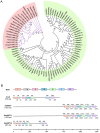Genomic sequencing and analysis of Sucra jujuba nucleopolyhedrovirus
- PMID: 25329074
- PMCID: PMC4201490
- DOI: 10.1371/journal.pone.0110023
Genomic sequencing and analysis of Sucra jujuba nucleopolyhedrovirus
Abstract
The complete nucleotide sequence of Sucra jujuba nucleopolyhedrovirus (SujuNPV) was determined by 454 pyrosequencing. The SujuNPV genome was 135,952 bp in length with an A+T content of 61.34%. It contained 131 putative open reading frames (ORFs) covering 87.9% of the genome. Among these ORFs, 37 were conserved in all baculovirus genomes that have been completely sequenced, 24 were conserved in lepidopteran baculoviruses, 65 were found in other baculoviruses, and 5 were unique to the SujuNPV genome. Seven homologous regions (hrs) were identified in the SujuNPV genome. SujuNPV contained several genes that were duplicated or copied multiple times: two copies of helicase, DNA binding protein gene (dbp), p26 and cg30, three copies of the inhibitor of the apoptosis gene (iap), and four copies of the baculovirus repeated ORF (bro). Phylogenetic analysis suggested that SujuNPV belongs to a subclade of group II alphabaculovirus, which differs from other baculoviruses in that all nine members of this subclade contain a second copy of dbp.
Conflict of interest statement
Figures








Similar articles
-
The genome sequence of Pseudoplusia includens single nucleopolyhedrovirus and an analysis of p26 gene evolution in the baculoviruses.BMC Genomics. 2015 Feb 25;16(1):127. doi: 10.1186/s12864-015-1323-9. BMC Genomics. 2015. PMID: 25765042 Free PMC article.
-
Genome sequence and analysis of Buzura suppressaria nucleopolyhedrovirus: a group II Alphabaculovirus.PLoS One. 2014 Jan 24;9(1):e86450. doi: 10.1371/journal.pone.0086450. eCollection 2014. PLoS One. 2014. PMID: 24475121 Free PMC article.
-
Sequence and organization of the Mamestra configurata nucleopolyhedrovirus genome.Virology. 2002 Mar 1;294(1):106-21. doi: 10.1006/viro.2001.1313. Virology. 2002. PMID: 11886270
-
Complete sequence, analysis and organization of the Orgyia leucostigma nucleopolyhedrovirus genome.Viruses. 2011 Nov;3(11):2301-27. doi: 10.3390/v3112301. Epub 2011 Nov 15. Viruses. 2011. PMID: 22163346 Free PMC article.
-
The genome sequence and evolution of baculoviruses.Annu Rev Entomol. 2003;48:211-34. doi: 10.1146/annurev.ento.48.091801.112756. Epub 2001 Sep 28. Annu Rev Entomol. 2003. PMID: 12414741 Review.
Cited by
-
The Operophtera brumata Nucleopolyhedrovirus (OpbuNPV) Represents an Early, Divergent Lineage within Genus Alphabaculovirus.Viruses. 2017 Oct 21;9(10):307. doi: 10.3390/v9100307. Viruses. 2017. PMID: 29065456 Free PMC article.
-
A Novel Alphabaculovirus from the Soybean Looper, Chrysodeixis includens, that Produces Tetrahedral Occlusion Bodies and Encodes Two Copies of he65.Viruses. 2019 Jun 26;11(7):579. doi: 10.3390/v11070579. Viruses. 2019. PMID: 31247912 Free PMC article.
-
Genome of Cnaphalocrocis medinalis Granulovirus, the First Crambidae-Infecting Betabaculovirus Isolated from Rice Leaffolder to Sequenced.PLoS One. 2016 Feb 5;11(2):e0147882. doi: 10.1371/journal.pone.0147882. eCollection 2016. PLoS One. 2016. PMID: 26848752 Free PMC article.
-
The complete sequence of the first Spodoptera frugiperda Betabaculovirus genome: a natural multiple recombinant virus.Viruses. 2015 Jan 20;7(1):394-421. doi: 10.3390/v7010394. Viruses. 2015. PMID: 25609309 Free PMC article.
-
Genome Characteristics of the Cyclophragma Undans Nucleopolyhedrovirus: A Distinct Species in Group I of Alphabaculovirus.Virol Sin. 2018 Aug;33(4):359-368. doi: 10.1007/s12250-018-0047-9. Epub 2018 Aug 28. Virol Sin. 2018. PMID: 30155853 Free PMC article.
References
-
- Herniou EA, Arif BM, Becnel JJ, Blissard GW, Bonning B, et al... (2011) Baculoviridae. In Virus taxonomy: classification and nomenclature of viruses: Ninth Report of the International Committee on Taxonomy of Viruses. Edited by King AMQ, Adams MJ, Carstens EB, Lefkowitz EJ. San Diego. Elsevier Academic Press.
-
- Lucarotti CJ, Morin B, Graham RI, Lapointe R (2007) Production, application, and field performance of Abietiv, the balsam fir sawfly nucleopolyhedrovirus. Virologica Sinica 22: 10.
-
- Aucoin MG, Mena JA, Kamen AA (2010) Bioprocessing of Baculovirus Vectors: A Review. Current Gene Therapy 10: 174–186. - PubMed
-
- Fauquet CM, Carstens EB, Estes MK, Lemon SM, Maniloff J, et al... (2000) Virus Taxonomy-Seventh Report of the International Committee on Taxonomy of Viruses. San Diego: Academic Press.
Publication types
MeSH terms
LinkOut - more resources
Full Text Sources
Other Literature Sources
Research Materials

